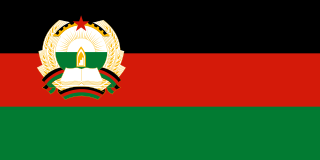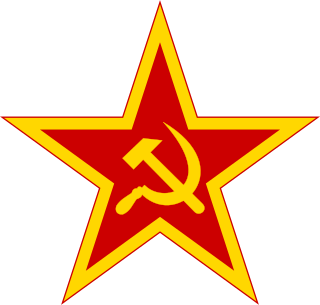Related Research Articles

Afghanistan, officially the Islamic Emirate of Afghanistan, is a landlocked country located at the crossroads of Central and South Asia. It is bordered by Pakistan to the east and south, Iran to the west, Turkmenistan to the northwest, Uzbekistan to the north, Tajikistan to the northeast, and China to the northeast and east. Occupying 652,864 square kilometers (252,072 sq mi) of land, the country is predominately mountainous with plains in the north and the southwest, which are separated by the Hindu Kush mountain range. As of 2021, its population is 40.2 million, composed mostly of ethnic Pashtuns, Tajiks, Hazaras, and Uzbeks. Kabul is the country's largest city and also serves as its capital.

The Yom Kippur War, also known as the Ramadan War, the October War, the 1973 Arab–Israeli War or the Fourth Arab–Israeli War, was an armed conflict fought from 6 to 25 October 1973 between Israel and a coalition of Arab states led by Egypt and Syria. The majority of combat between the two sides took place in the Sinai Peninsula and the Golan Heights—both of which were occupied by Israel in 1967 — with some fighting in African Egypt and northern Israel. Egypt's initial objective in the war was to seize a foothold on the eastern bank of the Suez Canal and subsequently leverage these gains to negotiate the return of the rest of the Israeli-occupied Sinai Peninsula.

The Democratic Republic of Afghanistan (DRA), renamed the Republic of Afghanistan in 1986, was the Afghan state during the one-party rule of the People's Democratic Party of Afghanistan (PDPA) from 1978 to 1992.

The Soviet–Afghan War was a conflict wherein insurgent groups known collectively as the Mujahideen, as well as smaller Maoist groups, fought a nine-year guerrilla war against the Democratic Republic of Afghanistan (DRA) and the Soviet Army throughout the 1980s, mostly in the Afghan countryside. The Mujahideen were variously backed primarily by the United States, Pakistan, Iran, Saudi Arabia, China, and the United Kingdom; the conflict was a Cold War-era proxy war. Between 562,000 and 2,000,000 Afghans were killed and millions more fled the country as refugees, mostly to Pakistan and Iran. Between 6.5%–11.5% of Afghanistan's population is estimated to have perished in the conflict. The war caused grave destruction in Afghanistan, and it has also been cited by scholars as a contributing factor to the dissolution of the Soviet Union and the end of the Cold War, in hindsight leaving a mixed legacy to people in both territories.

The T-34 is a Soviet medium tank introduced in 1940, famously deployed with the Red Army during World War II against Operation Barbarossa.

The T-62 is a Soviet main battle tank that was first introduced in 1961. As a further development of the T-55 series, the T-62 retained many similar design elements of its predecessor including low profile and thick turret armour. In contrast with previous tanks, which were armed with rifled tank guns, the T-62 was the first production tank armed with a smoothbore tank gun that could fire APFSDS rounds at higher velocities. While the T-62 became the standard tank in the Soviet arsenal, it did not fully replace the T-55 in export markets due to its higher manufacturing costs and maintenance requirements compared to its predecessor. Although the T-62 was replaced in Russia and the successor states of the Soviet Union, it is still used in some countries and its design features became standardised in subsequent Soviet and Russian mass-produced tanks.

MILAN is a Western European anti-tank guided missile. Design of the MILAN started in 1962, it was ready for trials in 1971, and was accepted for service in 1972. It is a wire-guided SACLOS missile, which means the sight of the launch unit has to be aimed at the target to guide the missile. The MILAN can be equipped with a MIRA or MILIS thermal sight to give it night-firing ability.

The Mil Mi-24 is a large helicopter gunship, attack helicopter and low-capacity troop transport with room for eight passengers. It is produced by Mil Moscow Helicopter Plant and has been operated since 1972 by the Soviet Air Force and its successors, along with 48 other nations.

The Antonov An-30, is a development of the An-24 designed for aerial cartography.

The BTR-152 is a six-wheeled Soviet armored personnel carrier, built on the chassis and drive train of a ZIS-151 utility truck. It entered service with a number of Warsaw Pact member states beginning in 1950, and formed the mainstay of Soviet motor rifle battalions until the advent of the amphibious BTR-60 series during the 1960s.

Sahabzada Yaqub Ali Khan SPk, was a Pakistani statesman, diplomat, military figure, pacifist, linguist, and a retired general of Pakistan Army.

The DShK 1938 is a Soviet heavy machine gun with a V-shaped butterfly trigger, firing the 12.7×108mm cartridge. The weapon was also used as a heavy infantry machine gun, where it was frequently deployed with a two-wheeled mounting and a single-sheet armour-plate shield. The DShK's name is derived from its original designer, Vasily Degtyaryov, and Georgi Shpagin, who later improved the cartridge feed mechanism. It is sometimes nicknamed Dushka in Russian-speaking countries, from the abbreviation. Alongside the American M2 Browning, the DShK is the only .50 caliber machine gun designed prior to World War II that remains in service to the present day.

The Mil Mi-1 was a Soviet three- or four-seat light utility helicopter. It was the first Soviet helicopter to enter serial production. It is powered by one 575 hp (429 kW) Ivchenko AI-26V radial. It entered service in 1950 and was first seen on the 1951 Soviet Aviation Day, Tushino and was produced for 16 years. More than 1,000 were built in the USSR and 1,594 in Poland, as SM-1.

The BTR-40 is a Soviet non-amphibious, wheeled armoured personnel carrier and reconnaissance vehicle. It is often referred to as the Sorokovka in Soviet service. It is also the first mass-produced Soviet APC. It was eventually replaced in the APC role by the BTR-152 and in the scout car role by the BRDM-1.

The Soviet Ground Forces was the main land warfare uniform service branch of the Soviet Armed Forces from 1946 to 1992.

The Type 63 multiple rocket launcher is a towed, 12-tube, 107mm rocket launcher produced by the People's Republic of China in the early 1960s and later exported and manufactured globally. Although no longer serving with active infantry units, the Type 63 is still in People's Liberation Army service with specialized formations such as mountain infantry units and special forces detachments. The Type 63 was widely used in the PLA until the late 1980s. It was adopted as the successor of the Type 50-5 of 102mm.

The ZSU-23-4 "Shilka" is a lightly armored Soviet self-propelled, radar guided anti-aircraft weapon system (SPAAG).
The 5th Guards Zimovnikovskaya order Kutuzov II degree Motor Rifle Division, named on the 60th anniversary of the USSR, was a military formation of the Soviet Ground Forces. It was formed from the 6th Mechanized Corps created in 1940 and destroyed in 1941 in the beginning of Operation Barbarossa. The corps was reformed in November 1942 under the same name, but with a different organizational structure. In early 1943, the 6th Mechanized Corps was granted "Guards" status and became the 5th Guards Mechanized Corps.

The Herat uprising, locally known as the Uprising of 24th Hūt was an insurrection that took place in and around the city of Herat in western Afghanistan, across several days in March 1979. It included both a popular uprising and a mutiny of Afghan Army troops against the Democratic Republic of Afghanistan (DRA). The communist regime at first appealed to its Soviet allies for help, but the Soviet leadership declined to intervene. After the insurgents seized and held the city for about a week, the regime was able to retake it with its own forces, and the subsequent aerial bombardment and recapture of Herat left 3,000 to 25,000 of its inhabitants dead. It was the worst outbreak of armed violence in the country in 50 years, and was the deadliest incident in the 1978-1979 period following the Saur Revolution and before the start of the Soviet occupation.
Aleksei Alekseievich Rodionov was a Soviet-Ukrainian diplomat who served as the Soviet Ambassador to Pakistan from 1971 until 1974 and the Ambassador of Ukraine to Canada after the Cold war from 1991 to 1992.
References
- ↑ J. Bruce Amstutz (1 July 1994). Afghanistan: The First Five Years of Soviet Occupation. DIANE Publishing. pp. 27–. ISBN 978-0-7881-1111-2 . Retrieved 24 August 2013.
- ↑ Summary of World Broadcasts: Far East. Monitoring Service of the British Broadcasting Corporation. 1987. Retrieved 24 August 2013.
- ↑ Middle East Insight. International Insight, Inc. 1987. Retrieved 24 August 2013.
- ↑ Anthony James Gregor (1989). In the Shadow of Giants: The Major Powers and the Security of Southeast Asia. Hoover Inst Press. p. 161. ISBN 978-0-8179-8821-0 . Retrieved 24 August 2013.